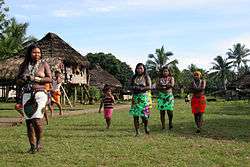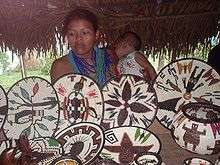Embera-Wounaan
 Embera girl dressed for a dance, Darién Province, Panama | |
| Total population | |
|---|---|
|
(15,000–16,000 (9,000–10,000 Embera and 6,000 Wuanana)[1]) | |
| Regions with significant populations | |
|
| |
| Languages | |
| Choco languages | |
| Related ethnic groups | |
| Caramanta people, Catío people |
The Embera–Wounaan are a semi-nomadic indigenous people in Panama living in Darién Province on the shores of the Chucunaque, Sambú, Tuira Rivers and its water ways. The Embera-Wounaan were formerly and widely known by the name Chocó, and they speak the Embera and Wounaan languages, part of the Choco language family.
Name
The name Embera means "people". Collectively they are known as the Chocó and belong to two major groups: the Embirá, of upper Atrato and San Juan rivers, and the Wuanana of the lower San Juan River. The Embirá are also known as the Atrato, Bedea, Cholo, Darién, Dariena, Eberá, Emberá, Emberak, Emperia, and Panama Emberá people. The Waunana are also known as the Chanco, Chocama, Noanama, Noenama, Nonama, Wounaan, or Wound Meu people. A third group of Chocó are called the Catío, who are also called the Embena, Epera, Eyabida, or Katio people.[1]
Housing

The Chocó, or Embera, people live in small villages of 5 to 20 houses along the banks of the rivers throughout the Chucunaque/Tuira/Balsas River watersheds in the Darien Province of Panama. There are generally three villages on each tributary that branches off from the main river system. Each village is about a half day's walk apart. The villages are built on a small rise, set approximately 100 feet in from the river. The houses of the village are set about 20–50 feet apart atop the rise on posts, with no walls, but tall thatched roofs. Around each village, the jungle is partly cleared and replaced by banana and plantain plantations, a commercial crop for the Embera, who sell them to get cash for their outboard motors, mosquito nets, and the like. The hills leading down to the river from the villages are usually hard packed reddish clay. There are sometimes large boulders being played on by naked children. Dugout canoes are usually seen pulled up on the riverbanks.

Their houses are raised off the ground about eight feet. The houses stand on large posts set in the ground, and have thatched roof made from palm fronds. All the joinery is with bejuco vines. There are no walls. Hanging from the supporting posts and beams are hammocks, baskets, pots, bows and arrows, mosquito nets, clothing and other items. The floor is made of split black palm trunks or cana blanca (white cane), and have a kitchen built on a clay platform about three feet square; on top of this base they build a fire, supporting cooking pots over the fire with a tripod of sturdy sticks. The houses are accessed from the ground via a sloped log with deep notches for a ladder. They sometimes turn the notches face down at night if some animal is trying to climb into the house while they sleep.
Society
The Chocó people use matrilineal descent, practice polygamy and live in family units. The cacique, or chief, of the Chocó lived in the largest village and capitol of the Chocó Nation, named Unión Chocó. The city is on the banks of the Tuira River.
The Chocó have their own form of government and live by their own set of unwritten rules. They avoid relying on the Panamanian Police (Guardia Nacional) or any other branch of the Panamanian or Colombian governments. Not assimilated into Panamanian or Colombian society, the Embera people do not hold any civic positions and have no members who have become part of the Guardia Nacional in Panama. Health care is primarily provided by trained shamans.
The Chocó do not intermarry with other Panamanians and Colombians.
The land is community owned and community farmed. Everyone in the village pitches in to work at harvest time. If one hunter gets a larger animal, such as a peccary or a tapir (macho de monte), everybody in the village shares the meat.
Economy

The calabash tree is important to the Embera, who scoop out the tree's gourds for cups and bowls, as well as spoons. Apart from wild fish and game, still hunted with snares, blow guns, bows and arrows, as well as firearms, an essential part of their diet is cassava, a poisonous root which must be pressed before cooking into a flatbread that stores well and can be used to absorb fluids during a meal.
Appearance

The men sport "bowl cut" hairstyles, and when not in towns, still wear nothing but a minimal loin cloth. The women wear brightly colored cloth wrapped at the waist as a skirt. Except when in towns, the women do not cover their torsos, and wear long, straight black hair. The children go naked until puberty, and no one wears shoes.
They paint their bodies with a dye made from Genipa americana, the berry of a species of genip tree. The black dye is thought to repel insects and the designs are known as Jagua Tattoos.[2] On special occasions, using this same dye, they print intricate geometric patterns all over their bodies, using wood blocks carved from balsa wood. The women also wear silver necklaces and silver earrings on these special occasions; many of the necklaces being made of old silver coins. They punch a hole in the coin and run a silver chain through it. Many of the coins on these necklaces date to the 19th century and are passed down from mother to daughter.
The Wounaan in Hollywood Films
The Wuanana tribe has appeared on screen in at least two Hollywood films. The first appearance was in Roland Joffé's The Mission, in which they portrayed the Guarani living in the Iguazu Falls region of Argentina during the Guaraní War in the 18th century. Later they portrayed the Taíno and Carib in Ridley Scott's 1492: Conquest of Paradise, a film about Columbus' discovery of the Americas. The tribe performed alongside such notable actors as Robert De Niro, Jeremy Irons, Liam Neeson and Gérard Depardieu, as well as Sigourney Weaver, Armand Assante, Frank Langela, Ray McNally, and others. Despite portraying other indigenous peoples, the Wounaan speak their own language in both films.
The most notable members of the tribe to act were:
- Bercelio Moya, who portrayed the Indian Boy who always followed De Niro's character in The Mission, and Columbus' translator Utapan in Conquest of Paradise.
- Alejandrino Moya, who portrayed the Chief's Lieutenant in The Mission, and the Taino cacique "Guarionex" in Conquest of Paradise.
Other unnamed members of the tribe can be seen acting in both films.
See also
- Comarca Emberá-Wounaan, indigenous territory in Panama
- Chafil Cheucarama, Wounaan artist and illustrator.
Notes
References
- Callaghan, Margo M. Darién Rainforest Basketry. 4th Ed. Sun Lakes, AZ: HPL Enterprises, 2009. ISBN 978-9962-00-640-4.
External links
| Wikimedia Commons has media related to Embera. |